#Jardin de Cactus César Manrique
Explore tagged Tumblr posts
Text
Aïe, aïe, aïe ! Ça pique au Jardin de Cactus de Lanzarote
Aïe, aïe, aïe ! Ça pique au Jardin de Cactus de Lanzarote
Voici une découverte que j’ai vraiment adoré! Cette visite doit incontestablement faire partie de vos incontournables lors de votre séjour à Lanzarote, c’est indéniable! Imaginez-vous : vous vous retrouvez au cœur d’une plantation de plus de 4500 cactus avec plus de 1400 espèces différentes ! Ça vous pique hein?? Il y a de quoi! Le Jardin de Cactus est un lieu emblématique de l’île. Nombreux sont…

View On WordPress
#Aéonium#Agave Shawii#Aller au Jardin de Cactus Lanzarote#Arbre pieuvre#Art César Manrique#Attractions phares Lanzarote#Biographie César Manrique#Blog Voyage Lanzarote#Cact Lanzarote#CACT Lanzarote tarif#Cactus Lanzarote#Centre Naturel Lanzarote#Cephalocereus Senilis#César Manrique#Cojines de Suegra#Coussin de Belle-Mère#Création de César Manrique#Echinocactus Grusonii#Euphorbia Candelabrum#Ferocactus Pilosus#Gofio Lanzarote#Goûter du cactus#Hembra y Macho#Jardin de Cactus#Jardin de Cactus César Manrique#Jardin de Cactus Guatiza#Jardin de Cactus Lanzarote#Jardin de Cactus Tarif#Lanzarote Blog#le Jardin de Cactus
8 notes
·
View notes
Text




WHAT TO DO IN LANZAROTE BY CRUISE SHIP?
🌍Timanfaya National Park Covering over 12,600 acres, this lunar landscape looks much like it did after violent volcanic eruptions spewed chunks of molten lava over the entire area.
🌍César Manrique Foundation The artist's former house and studio sit on top of a volcanic trail, its interior built around five volcanic bubbles. Since 1982, the Foundation has worked for the conservation, research and promotion of Manrique's work.
🌍Jardin de Cactus Built on an old quarry of volcanic ash extraction, the garden features 10,000 types of cactus from over 1,400 distinct species. Outside the entrance stands the towering 26-foot tall green metal cactus, Manrique's last work.
🌍Mirador del Rio
Lanzarote's most famous viewpoint is situated on Famara Cliff. The stone structure's semi-circular shape and large domed roof offer breathtaking views over the northern coastline, and the island's oldest salt plains.
🌍Bodega Translated as "wine cellar," a bodega is a warm and welcoming wine shop, tasting room or marketplace where visitors can sample or purchase wine.
🌍Puerto del Carmen
Just south of Lanzarote, this tiny fishing village boasts warm, golden beaches that overlook the Atlantic. Renowned as the most tranquil in the Canary Islands, the water is perfect for swimming and other water sports.
#lanzarote#spain#arrecife#cruise ship#sightseeing#holiday#visit#port of call#cruisedestination#espana#canaryislands#canarias
0 notes
Text
Lanzarote Holidays - the Volcanic Canary Island

Located in the japanese corner of Canary Island, Lanzarote is an interesting Spanish island with ton to present for a superior holiday break. The southern component of Lanzarote is dominated with wonderful volcanoes, formed by 18th century old eruptions. The island has beaches, volcanoes, h2o functions, astounding resorts, sparkling nightlife, delightful cuisines and several other recreation facilities to make your holiday in Lanzarote a occurring 1. Adhering to are some of the famed vacationer attractions to be visited when holidaying in Lanzarote: Timanfaya Vacation in Lanzarote is incomplete without the need of a check out to the volcanic zone or the volcanoes, also recognized as Fireplace Mountain. In calendar year 1968 the Parque Nationwide de Timanfaya was declared as a national park, which is right now a significant tourist attraction for all the overseas travellers and guests. The region also has amazing camel ride which requires vacationers and people to the hill. Thanks to large crowd of website visitors and vacationers on a getaway in Lanzarote, the place also has delicacy of mouth watering and grilled meals served at renowned El Diablo restaurant at the peak of the hill. The Cactus Backyard garden Developed and planned by Cesar Manrique, El Jardin del cactus garden delivers an tasteful selection of around 1000 distinctive cactus species. The wide range of cacti choice was picked out by Estanislo Gonzales Ferrer, Botanist. Fundación César Manrique This foundation of renowned artist Cesar Manrique is usually visited by a massive variety of travellers every single working day. The foundation is much more of a showcase of this eminent artist, his existence and perception. When holidaying in Lanzarote it is significant to acknowledge the artist's and his perform, to fully grasp and complement the attractiveness of this canary island. To know more about Lanzarote visit at https://en.wikipedia.org/wiki/Lanzarote Jameos Del Agua James Del Agua was when an underground lava bubble which was converted into today's theater and auditorium. This vacationer attraction is a hit amid many vacationer and visitors holidaying in Lanzarote. a hundred m lengthy and 30m in width, this volcanic bubble is roofless and has swimming pool, back garden along with a bar and dance ground designed out of the rocks of volcano. Aquapark, Costa Teguise Holiday getaway in Lanzarote can be enjoyable with loved ones too. This massive aqua park of Lanzarote brings all the household enjoyable as its offer you water rides, flumes, pools and plenty of h2o. Tourist and readers holidaying in Lanzarote generally stop up at this drinking water park, to relaxation and appreciate amongst their excursions to island's astounding beauty. You would like to get more info relating to click web page. Wine museum El Grifo With over forty,000 tourist and visitors shelling out a take a look at to it every year, El Grifo is the significant and really admired wine museum. The wine generating region of this island is well worth paying a visit when holidaying in Lanzarote. The museum also has a monument of Grifo, a do the job of artwork by well-known Cesar Manrique.
1 note
·
View note
Text
LABORATORIOS DE CULTIVO
Después de visitar los invernaderos de campo de Dalías pudimos observar la importancia que la biotecnología tenía sobre la zona. El estudio de nuevas especies para cultivo, obtener tamaños deseados en piezas cultivadas, mejora de sabor, textura ... era algo fundamental en la producción en los huertos.
Para la mejora del entorno y poder darle nuevo uso a nuestra parcela y alejar la densificación de plásticos de la zona, obtamos por la implantación en nuestra parcela de dos edificios destinados a laboratorio biotecnológico más uno destinado a exposición de los procesos productivos que caracterizan la zona. Este tercer edificio, además, tendrá zona de oficinas encargada de la gestión y distribución de las nuevas semillas obtenidas en el laboratorio. El edificio está coronado por una zona de cafeteria-restaurante que da servicio al entorno.


En el resto de la parcela se decide colocar un jardin de cactus, acorde con la climatología de la zona. El jardín que ha inspirado la idea es el que se encuentra en la isla de Lanzarote, de César Manrique, Premio Internacional Carlo Scarpa.
0 notes
Photo

AIE, AIE, AIE, OUILLE, OUILLE, OUILLE !!!
Dans la vie, il y a des cactus..., et beaucoup d’espèces se retrouvent dans le “Jardin de Cactus” créé par César Manrique sur son île de Lanzarote. En dehors de l’aspect visuel très réussi de l’ensemble, voici un “cactusilège” destiné à mettre un peu de piquant dans la lecture de ce billet...
Comme pour le “florilège” à Madère, vous avez droit à une revue non exhaustive et redondante des cactus plantés dans ce jardin. Tout d’abord, voici la preuve que le cactus de l’en-tête est dû à l’artiste

Ensuite, un petit rappel d’ensemble

et enfin, la litanie en vrac :

et

et

et

et

et

et

et

et

et

et

et en agrandissant

Puis

et

et

et

et

et

et

et

et

et

et

et

et

et

et

avec un petit clin d’œil de César pour terminer

0 notes
Photo

Lanzarote⠀ El Jardín de Cactus es una de las obras de César Manrique en Lanzarote. Está ubicado en una antigua cantera, a modo de cráter, y contiene una amplia representación de esta planta autóctona de la isla.⠀ Los edificios adjuntos siguen la arquitectura clásica de Manrique, con sus preciosas escaleras de caracol.⠀ Síguenos en Instagram bit.ly/instaglb (en Jardin De Cactus) https://www.instagram.com/p/B3O0dVuIpKy/?igshid=a3ttdugf27n5
0 notes
Video
youtube
JARDIN DE CACTUS - LANZAROTE ATTRACTION Coordonnées GPS: 29.080560, -13.476368
Le Jardin de Cactus est un magnifique jardin botanique qui abrite des milliers de cactus provenant de plusieurs continents.
Il est situé au nord de l'île dans la commune de Teguise. C'est le dernier projet réalisé par César Manrique.
Étant situé dans une ancienne carrière, il est érigé en forme d'amphithéâtre. Dès que l'on entre dans son enceinte, nous bénéficions d'une superbe vue panoramique sur l'ensemble du site.
A première vue, nous apercevons un splendide moulin à vent qui surplombe les nombreux cactus à travers lesquels on retrouve de grands monolithes.
Un sentier a été érigé et nous amène à admirer la beauté particulière de chacun de ces cactus.
Nous pouvons également nous promener sur les différents paliers de la terrasse afin de découvrir de plus petites espèces de cactus dont plusieurs étaient en fleurs lors de notre passage.
L'intérieur du moulin à vent est accessible et nous permet de découvrir le mécanisme qui servait jadis à moudre le grain.
Je vous invite donc à visionner cette vidéo qui vous permettra de découvrir ce jardin qui nous a grandement épaté.
Pour plus d'infos, je vous invite à consulter le site suivant: https://www.cactlanzarote.com/fr/cact/jardin-de-cactus/
********************************************************************
AUTRES VIDÉOS :
https://www.youtube.com/playlist?list=PLlRroQCNvchtL9oV2d1KjHILi7JwzDvoZ
ABONNEZ-VOUS ► https://www.youtube.com/c/SouthAngelVideo?sub_confirmation=1
SUIVEZ NOUS :
• BLOGGER ► http://southangelvideo.blogspot.ca/ • INSTAGRAM ► https://www.instagram.com/annestrasbourg/ • FLICKR ► http://www.flickr.com/photos/anne_strasbourg/collections/ • TWITTER ► https://twitter.com/AnneStrasbourg
0 notes
Text
The best places in Lanzarote to visit: your island guide
I’ll be straight up about it, although Lanzarote has a mixed reputation around Europe, even attracting some unflattering nicknames such as Lanza-grotty, a little bit of me fell in love with the island.
Many visitors are tempted to Lanzarote by the offers of cheap all-inclusive resorts found across the island. They spend most of their days sipping gin and tonics by the pool, only venturing out for an organised day tour that crams as many places as possible before getting back in time for a gluttonous buffet dinner.
While there is nothing wrong with this, I feel it is doing the island a disservice and with so many things to do in Lanzarote, visitors should really try to explore further.
By far the best way to explore would be to hire a car and drive yourself. However, if you would rather let someone else take care of the details, there are plenty of Lanzarote day trips and tours also available.
The Travel Blogs Guide, places to visit in Lanzarote
In this post, I’ll cover many of the best things to do on in Lanzarote complete with my (mostly) first-hand experience as well as opening hours and price, where applicable, as well as the amount of time I’d recommend for visiting.
To read it in whole I’d estimate it’s a 6-7 minute read, but feel free to use the map or the contents just below to get to where you need to go quickly!
Your Lanzarote guide . . . feeling lazy? Feel free to skip ahead
1. Discover the work of César Manrique
1.1 Volcano House 1.2 The Cactus Garden 1.3 César Manrique House Museum 1.4 Monumento a la Fecundidad 1.5 Museo al Campesino
2. Volcanic Lanzarote
2.1 Timanfaya National Park 2.2 Timanfaya visitor centre 2.3 Playa del Charco de los Clicos & El Lago Verde 2.4 El Golfo 2.5 Los Hervideros and Playa Montaña Bermeja
3. Lanzarote Viewpoints
3.1 Mirador Del Rio 3.2 Las Salinas del Janubio 3.3 Other scenic viewpoints
4. Lanzarote’s Caves
4.1 Jameos Del Agua 4.2 Cueva de los Verdes
5. Lanzarote Markets
5.1 Teguise Market 5.2 Uga Market 5.3 Costa Teguise Night Market 5.4 Playa Blanca Market 5.5 Puerto del Carmen 5.6 Arrecife
6. Lanzarote vineyards
7. Non-volcanic beaches in Lanzarote
7.1 Playa de Papagayo 7.2 Playa de Famara 7.3 Playa de Orzola
8. Visit the Island of Graciosa
Affiliate disclosure: The links to tours or accommodation in this post are affiliate links. This means if you purchase after following one of these links, I make a small commission at no cost to yourself. Think of it like a win-win
The shaping of Lanzarote
The defining moment the history of Lanzarote was in the 1700s when multiple violent volcanic eruptions shook and reshaped the island, changing the life of residents forever.
This fiery destruction has left behind a geologist’s dreamland of stark, alien-like landscapes, stunning caves and a cultural history that shaped the work of the island’s most famous artist, César Manrique.
While there are many Lanzarote day trips and tours, my recommendation would be to hire a car for at least two days and discover the island for yourself.
Here is my list of places to convince you to leave the gin and tonic by the pool for the day and discover some of the wonderful sights of Lanzarote.
Discover the work of César Manrique
Like most people, probably, I hadn’t heard of César Manrique before arriving in Lanzarote, but you don’t have to explore far to discover the influence of his work and how he shaped tourism on the island.
César Manrique was born in Lanzarote, studied art in Madrid, worked in New York for a few years before returning to his homeland.
His work spans from Impressionist and Modern Art painting and sculptures to visionary architecture and he has helped to make Lanzarote the international tourist destination it is today.
Throughout this whole post you will see his name mentioned with various projects he has been involved in, but here are some of the best places to learn more about the man that made Lanzarote.
Casa del Palmeral
Otherwise known as Volcano House, Casa del Palmeral is an art gallery dedicated to César Manrique and his contemporaries in a house that he designed himself and lived in for over 20 years.
While the paintings were a little lost on me (I’m a bit of a philistine heathen when it comes to paintings) the house didn’t disappoint.
The house as seen from the parking area
From the outside the house looked like just another white building, but once we were inside we could truly see the imagination of César Manrique while wandering the many passageways.
The gallery has a designed route that guides through cave rooms built around five natural volcanic bubbles and interconnected by tunnels excavated in the lava, complete with a small, but gorgeous, swimming pool.
It definitely has a touch of a mini Playboy Mansion about it.
One of the lava tunnels that make up part of the Casa del Palmeral
The final room is a large, open gallery, showcasing some of his larger paintings and a couple of videos (in Spanish) about his life.
Finally, before we left we had a quick coffee and snack in the small cafe, complete with a couple of friendly cats.
As an introduction to César Manrique, I would highly recommend visiting the Fundacion, even if you (like me) aren’t a massive art buff, the gallery does help get a feeling for the man and his motivations.
Visitor Information Hours: Open every day from 10am – 6pm (holidays may vary) Cost of entrance: €8, children under 12 €1 How much time to spend there: 1 – 2 hours More info: Volcano House
The Cactus Garden
As we approached, The Cactus Garden gave none of its secrets away, all that marked the location was a traditional windmill. Well, that plus the car park with large signs saying welcome to the Cactus Garden.
Designed by César Manrique, El Jardin de Cactus is located in the north of Lanzarote, close to the village of Guatiza. The garden is home to more than 4500 cacti of 450 different species in a disused quarry.
Having parked the car, we paid our entrance fee, entered the garden and were immediately amazed. We found we stood at the top of the old quarry with the garden laid out in front of us as carefully terraced slopes running around the outside and the windmill towering above to our left.
The Cactus Garden
Each of the cacti have a small plaque marking the species and origin. We were quickly putting our botany skills to the test, guessing where each one came from as we slowly made our way down to the centre of the bowl and the small lake at the lowest point.
I’d highly recommend finding some time to visit The Cactus Garden. I’m not sure what it is, but there is something fascinating about cacti and I had a lot of fun exploring and taking photos of the many different types.
As well as the windmill, there is also a cafe and small gift shop within the grounds, selling local souveniers, and of course cacti.
Visitor Information Hours: Open every day from 10am – 5:45pm (holidays may vary) Cost of entrance: Adults €5.80, children aged 7 – 12 €2.90 How much time to spend there: 1 hour, longer if you want to enjoy the café. More info: Cactus Garden
César Manrique House Museum – Haría
We didn’t actually make it to César’s house, but it came highly recommended by a German couple we got talking to at Volcano House.
The couple have visited the museum every year for more than the last 20, which seemed a little over-enthusiastic to me, but still, a solid recommendation.
The house is in the small village of Haria, in the north of Lanzarote, and was the artist’s workshop in the later years of his life before his death in 1992. It now remains untouched after his death with many of his utensils and personal objects on display, kind of a time capsule standing as a testament to his work.
Visitor Information Hours: Open every day from 10am – 5:45pm (holidays may vary) Cost of entrance: €10, children 12 or under €1 How much time to spend there: 2 hours More info: Manrique House Museum
If you plan to visit both the César Manrique House Museum and Volcano House, you can purchase a multi-ticket for €15, saving €5.
Monumento a la Fecundidad
The chances are that if you hire a car to see Lanzarote, you will pass the Monument . . . many times as it sits in the geographical centre of the island.
The Monument was designed by César Manrique and stands in honour of the Lanzarote farmers, past and present, who struggle in their daily lives to produce a living from the volcanic land of Lanzarote.
Monumento a la Fecundidad
Visitor Information Hours: Always accessible Cost of entrance: Free How much time to spend there: 10 – 15 mins
Museo al Campesino
Just behind the Monumento a la Fecundidad is the Museo al Campesino. Broken up into multiple rooms, each of them represents a different traditional island craft. With multiple shops, this is one of the best places to pick up your authentic Lanzarote souvenirs
Museo al Campesino
Visitor Information Hours: Centre, shop and cafe: 10am to 5:45pm (from 9am in the summer). Restaurant: 12pm – 4pm Cost of entrance: Free How much time to spend there: 30 mins (unless you love to shop or want to eat, then maybe a little longer) More info: Museo al Campesino
A few suggested Day Trips
Volcanic Lanzarote: getting to the crust of the matter
As mentioned above, over 250 years ago, much of Lanzarote was covered in lava by violent volcanic eruptions. Although there are some places where you can walk on the lava, the majority of the black stuff makes up the protected area of Timanfaya National Park.
Timanfaya National Park
Also known as Las Montañas del Fuego, a visit to Parque Nacional de Timanfaya is a highly recommended experience that you can easily do as part of an organised tour or hire a car and drive there yourself, which I would recommend.
Car & Bus Tour
This is how we visited. We drove ourselves to the entrance, located in the west of Lanzarote, off the LZ-67 between Yaiza and Tinajo, paid the guards the 8€ per person entrance fee (young kids are free) and drove on through to the visitor centre which is about 1 km up the road.
If you decide to self drive, I highly recommend you get there early as we arrived at 10:30am and there was already a long queue.
The main part of a park visit is made up by a bus ride through the lava fields accompanied by a recorded commentary that plays Spanish, English and German, talking about life on the island before and after the eruptions.
Once we had made it to the car park, we were directed to the next bus and hopped on. The bus ride took about 30 minutes, most of which was spent looking nervously out of the window, wondering how the driver could actually navigate the large coach along the tiny roads and through the carved out lava.
Tip: Try to sit on the right-hand side of the bus as you face forward as this has by far the better views. Unfortunately, I chose wrong.
The views of the landscape are spectacular, the different shades of volcanic ash as it changes from red to black with the odd green shrub growing out of the scorched earth . . . I imagine the park would be a stunning location for many a sci-fi movie.
As the bus climbs higher there are some wonderful views back to Yaiza before reaching the highest point where we could look down into one of the many volcanic craters in this area.
When our bus tour was over, we spent some time looking around a small shop selling Lanzarote souvenirs and checked out the unique grill used by the onsite restaurant, El Diablo, which was designed by guess who? . . . Yep, that man César.
Chicken cooking over the volcano.
The grill is basically a giant well dug into the volcano, but rather than water at the bottom, there is immense heat that the restaurant uses to cook some of their food. We were able to walk up and take a look down. If you do too, be warned, as you peer down into the oven, you will get a hot blast hit your face.
Timanfaya Park volcano displays
Outside the restaurant some of the Timanfaya National Park staff show the power of the land in two different ways.
The steam shoots out after the water is almost instantly vaporised by the heat of the volcano just a few metres below your feet.
The first is where they pour a bucket of cold water down a pipe where it is vaporised by the natural heat that still resides in the volcano and explodes back out about 2 seconds later.
If you want to catch a photo of the spray, you had better be quick on the trigger.
The other part is where they have a small fire going, sparked by the heat of the volcano only a few metres below your feet.
The volcano sparking fires
They are both impressive displays of the volcano, but I also found them worrying, like they are just poking the volcano with a stick, making it do tricks for the public. I worry that one day it will get tired of performing and explode . . . I hope I’m nowhere near when it does.
Visitor Information Hours: Timanfaya National Park can be visited daily between 9am and 5pm (7pm during summer season) Cost of entrance: Adult: €10 per adult including coach tour. Children between 7 and 12 years €5. How much time to spend there: A visit with bus ride and mooching around the top will take about 2 hours. Longer if you want to try out the volcano cooked meat in El Diablo Restaurant. More info: Timanfaya National Park
By Camel
Yep, you read that right, you can also visit by camel!
The Echadero de los Camellos is also located along the LZ-67 in Parque Nacional de Timanfaya, a little further south of the main car entrance.
Personally I’m not a big fan of mass tourism animal rides so I chose not to do this.
If you fancy a camel ride tour of Timanfaya, it costs €12 per camel, but each camel can take two people with the tour lasting 20 minutes.
Timanfaya visitor centre
If you are interested in learning more about Lanzarote’s volcanoes above and beyond what you learn on the tour then just south of Tinajo, on the LZ-67, is the main visitor centre packed full of information.
Given how busy the tours get, I’d definitely recommend visiting the lava fields first and doing Timanfaya National Park bus tour before it gets too busy, then heading to the visitor centre afterwards.
Vistor Information Hours: The visitor centre can be visited daily between 9am and 5pm (6pm during summer season) Cost of entrance: Free How much time to spend there: 30 mins to an hour. It depends how much you can read about geology before your eyeballs try to run away. I mean, it’s good to learn, but sometimes reading about the actual scientific ins and outs can be pretty dull. Still, worth popping in if you have a car.
Lanzarote’s black beaches
The black beaches were one of the things I was looking forward to seeing as they are rare. There are a few to choose from along the west coast, including El Golfo and Las Salinas, more on both of them in a bit, but the one that almost everyone wants to see is Playa del Charco de los Clicos.
Playa del Charco de los Clicos & El Lago Verde
Also known as the one with the green lake, El Lago Verde, is probably the most well known of the Lanzarote black beaches. It’s worth noting that this beach is for viewing rather than taking a picnic to and relaxing for the day. The ocean is far to dangerous here for bathing.
The local name for the beach is La Laguna de los Clicos and can be found just outside the village of El Golfo. There is a large car park to the left of the road as you arrive into El Golfo and a small walk from the car park tp the lake. Just be aware the path can be steep and uneven in places.
The beach is formed in a volcanic crater of which half is submerged. But it is the The lake part is that draws people to view.
The lake shimmers a bright emerald green in stark contrast to the surrounding black sand. The green comes from a type of phytoplankton that feeds on the volcanic elements in the lake and is thought to be unique to the area.
El Lago Verde is a popular attraction with many coach tours so it is quite possible that it will be busy when you visit. However, with visits generally taking no more than 30-minutes you can just relax and it won’t be long before it quietens down. As with any popular site there will be locals selling souvenirs and welcome refreshments.
youtube
El Golfo
Next to El Lago Verde is El Golfo, is a small village set among the lava of the west coast where the striking white buildings are a real test for the eyes – if it is sunny, don’t forget your shades!
It is a wonderful place to visit for a wander along the stony beach and some traditional Lanzarote food while enjoying the sound of the waves against the volcanic rocks.
Los Hervideros and Playa Montaña Bermeja
Los Hervideros is a street of volcanic cliffs that make an incredible coast drive in the West of Lanzarote.
The black cliff faces create bizarre shapes and caves as hundreds of years of waves have eroded chunks of solidified lava.
The Northen part of the Los Hervideros ends with a lovely little beach, Playa Montaña Bermeja, complete with it’s own small lake. There us a small paking area opposite so you can get out, strech your legs and take a closer look.
The cliffs of Los Hervideros
The beach starts off with rather large, chunky black stones that have been smoothed by the sea throughout the years. But as we got closer to the water, the stones get finer until we found the black sand.
It can be reached on a small loop road, the LZ-703, which is easily accessed from the LZ-2, the main road to the south.
There is also (as the name would suggest) a natural green lake to the side of the beach. The colour comes from a type of algae that makes its home there, and while I did see some people swimming in there, I wouldn’t want to myself.
The beach and lake also adjoin a large lava field so I was able to climb and explore the black stuff a little more. Be sure to take half decent shoes with you, as I found out the hard way that lava can be rather sharp and flip-flops don’t offer much protection!
Find a place to stay
Booking.com
Lanzarote Viewpoints
One of the biggest pleasures of driving is discovering scenic roads with wonderful viewpoints and Lanzarote does not disappoint.
Mirador Del Rio
This is the most famous of the viewpoints in Lanzarote, and rightfully so. Yet another brainchild of that man César, the Mirador Del Rio sits 400 metres up on the Risco de Famara cliff, overlooking the island of Graciosa and the Atlantic Ocean beyond.
We paid our entrance fee and walked into a large cafe with panoramic views of the island below. The white curves of the building gave it the feeling of a James Bond-esque lair from the 70s heyday of the movies.
I quickly moved to grab a table next to the window and we enjoyed a well made coffee (and chocolate donut) while taking in the view.
A coffee and a view? I don’t mind it I do
Once the coffee was finished and the donut demolished, we set out to explore a little further. There is a door to the outside where we could get right to the edge of the cliff and tested our nerves by looking over the edge.
There is also a second view point, not to be missed, a little higher up. At the back of the cafe is a spiral staircase that leads to a stylish souvenir shop and a little higher up the second viewpoint.
While there is no doubt this is a stunning view point, I did feel that having to pay to get in and then pay for the cafe as well, was a little uncalled for. While not super expensive, €4.50 per person, by the time you’ve added on a pit stop in the cafe, the cost does creep up.
La Graciosa
Visitor Information Opening hours: 10am – 5:45pm Cost of entrance: €4.50 per adult, children aged 7-12 €2.25 How much time to spend there: 30 mins not including cafe time More info: Mirador del Rio
The rest of the viewpoints don’t have entrance fees or opening hours.
Las Salinas del Janubio
The Salinas is a curious viewpoint and beach which is also home to a salt-making business. The sea water is fed into various lagoons at different times and as the water evaporates, salt is left behind.
I’m sure there is probably much more to it than that, but the process seems simple in my mind.
What this creates is a patchwork of hues as the various lagoons are in different states of evaporation. A nice stop for a few minutes on your way to somewhere else, but unless you are using one of the restaurants in this area, I would not plan on spending more than a few minutes here.
Other scenic viewpoints
As you drive around Lanzarote keep an eye out as there are viewpoints everywhere. A few more of my favourites are the Valle de Malpaso Haria, overlooking the village of Haria, the road up here is a perfect mountain road ascending quickly via a number of switchback bends.
Los Hervideros on the volcanic coastline and the Mirador de Ermita de las Nievas. Just be careful with the last one as the roads leading to it aren’t in the best condition.
Going underground: Lanzarote’s Caves
The volcanic eruption of Mount Corona, 4000 years ago in the protected area of Monumento Natural del Malpaís de La Corona, left behind a web of jameos (lava caves) that have been turned into two of the most visited tourist attractions in Lanzarote.
Jameos Del Agua
The Jameos del Agua is a Centre of Art, Culture and Tourism and another brainchild of Lanzarote artist César Manrique. His vision and creativity has turned the Jameos Del Agua into a stunning subterranean salt lake, restaurant, gardens, emerald-green pool, museum and concert hall seating up to 500 people.
While some feel that the caves are overworked and lost any natural beauty they once had, others agree that Jameos Del Agua has achieved its goal perfectly in creating an eco-tourist site that shows off the natural beauty of the lava tunnels while making it accessible and enjoyable for the many visitors.
Be sure to keep an eye out for the endemic Munidopsis polymorpha, a species of squat lobster (also known as the blind albino cave crab).
Photo credit: Lmbuga [CC BY-SA 3.0 ], from Wikimedia Commons
Visitor Information Opening hours: 10am to 6:30pm Cost of entrance: €9 adults, €4.50 for children aged 7-12 How much time to spend there: 2 hours More info: Jameos Del Agua
Cueva de los Verdes
Located just 200 metres away from the Jameos Del Agua, Cueva de los Verdes offers a slightly different experience in that it is much more natural. While there is still a lot of work that has been done there, a visit feels like more of an adventure than the Jameos Del Agua.
A visit to the caves takes place as a guided tour in which you slowly make your way through many of the lava tunnels. Some of them do get tight, so if you are super claustrophobic (and especially if you are with a large group) it may not be the best idea, but otherwise a wonderful exploration.
Remember to wear solid footwear as the ground can be a bit uneven underfoot.
Photo credit: Lviatour [CC BY-SA 3.0], from Wikimedia Commons
Visitor Information Opening hours: 10am to 6pm Cost of entrance: €9 adults, €4.50 for children aged 7-12 How much time to spend there: The tour takes around 1 hour More info: Cueva de los Verdes
Find a local market
Many of the small towns and villages of Lanzarote host markets throughout the week.
Teguise Market
Every Sunday from 9am to 2pm Teguise Market is probably the most popular and well-known market in Lanzarote and is held every Sunday in Teguise where seemingly the whole of the island turns out. It’s a well-organized affair with car parking guides showing visitors to parking spaces and charging a couple of euros to park.
Although there were many people, the market didn’t feel busy as it is so large, taking over the entire town.
The market is home to stalls selling a wide range of goods including local crafts, fashion, art and much more. There is also a good selection of local shops with traditional clothing, local produce and wine (more on the Lanzarote wine coming up) and so on.
For me, however, the highlight of the day (as it often is) was lunch. There are many street food vendors available, but we found a small hotel and restaurant called Casa Palacio Ico.
Now while the food was not cheap, it was certainly tasty. We shared a whole baked seabass with the traditional local seasoning, mojo picon, and it was delicious. Juicy in all the right places.
However, delicious food aside, I have never encountered such a friendly team off staff, from the young man who welcomed us to the manager on the day.
Sorry, I’m going a little off track here, but I’m going to continue.
To give you a little context, my wife and I were actually on honeymoon in Lanzarote with our 14-month son. He had been playing up a bit, as toddlers do, and we hadn’t been able to properly relax and enjoy a meal together up until this point.
When our food arrived, the manageress, who had earlier told us that she has two kids of her own and sympathises with us, came and took our little Javi, held him, looked after him and basically baby sat him so we could enjoy our meal.
He had a busy time looking at all the fascinating things in the restaurant, being chased, and we could finally relax and enjoy a meal. He was never taken out of our sight, so it was 100% safe, and this small gesture almost (did) have me in tears.
If you have kids, you probably understand why that small act of kindness meant so much, we could relax and enjoy. If you don’t have kids yet but hope to, you’ll understand one day, and I hope you find somewhere like Casa Palacio Ico.
OK, back on track!
The rest of these markets we didn’t actually visit, however I have included the information to help you plan your trip to Lanzarote.
Uga Market
Every Saturday and Sunday from 9:30am to 1:30pm Uga is a town in the south of the island and also the gateway to the La Geria wine region. The market is twice a week and sells a wide range of local produce, wine and cheese as well as soaps and other health products made with local aloe.
Costa Teguise Night Market
Every Friday 5pm to 10pm Each Friday evening, the Plaza Pueblo Marinero in Costa Teguise, comes to life with a handicraft night market. Not far from the beach marina, this is a perfect little spot so grab some Lanzarote souvenirs before heading for a beachside dinner in one of the many restaurants.
Playa Blanca Market
Wednesday & Saturday from 9am to 2pm The Playa Blanca market takes place in the Marina Rubicón, to the east of the main clutch of Playa Blanca Hotels.
It would be necessary to catch a bus or grab a taxi if you are not in the immediate area, but it wouldn’t cost much to get there.
The market has a range of stall in a wonderful setting including artisanal products, handmade jewellery, crafts, fashion and much more.
There is also smaller market in Playa Blanca every Friday morning in Punta Limones. This is where the smaller marina is located which is used by the passenger ferries between Lanzarote and Fuerteventura.
Puerto del Carmen
Every Friday from 10am to 2pm Located in the Plaza de El Varadero de La Tiñosa, the small market sells a wide range of crafts and also offers entertainment throughout.
Arrecife
Every Wednesday and Thursday from 9am to 2pm Arrecife is the capital of Lanzarote and markets are held each week in an area known as Charco de San Ginés, which is right down by the harbour. The market sells jewellery, crafts and fashion and there are also many fine restaurants to choose from in this area.
Enjoying Lanzarote wine and the vineyards of La Geria
Wine served just the way I like it, with a straw
The region of La Geria is where almost all of the Lanzarote wine comes from and the good news is, most of the Lanzarote vineyards are open for business.
After the volcanic eruptions, the winemakers of Lanzarote had to go to extreme lengths to be able to produce wine once more. The result of their efforts was a unique type of viticulture in a fantastic climate making some wonderful wines.
Due to the nature of the vineyards, everything must be produced by hand which means Lanzarote wine isn’t cheap (compared to other Spanish wines) but is definitely good quality.
If you want to know more about the vineyards, check out my other post which has loads of information about the winemaking process and 10 vineyards in Lanzarote that you can visit.
The small moon-shaped walls, known as zocos, protect the grapes during cultivation
Non-volcanic beaches in Lanzarote
While Lanzarote is famous for the black beaches mentioned earlier, there are also some wonderful regular beaches too. Here are some of the best:
Playa de Papagayo
This is in the south east of the island, not far from Playa Blanca and can be a welcome escape from an all inclusive resort.
The beach is in a bay which means the emerald water is almost always calm. The water is also shallow, so an ideal beach for the kids.
The only drawback is that the beach is one of the more popular and can get busy, so try to get there early to snag your spot.
Playa de Famara
In the north west of Lanzarote, you’ll find Playa de Famara. This is a spectacular natural beach with the large cliffs providing a dramatic backdrop to the north. Sadly, when we visited, it was bucketing down with rain, so we didn’t get to fully enjoy the beach.
The area is known for strong winds which can mean it’s not the perfect beach for a relaxing day at the seaside, but perfect if you want to try kitesurfing while you are in Lanzarote.
The small village of Caleta de Famara has a few schools and places where you can either take a lesson or simply hire the kite surfing equipment and try your luck!
Playa de Orzola
We loved this beach that we discovered after visiting the Mirador del Rio in the north of Lanzarote. The beach was really quiet, which was wonderful, and we spent a couple of peaceful hours relaxing and soaking in the views. The big drawback, however, is that due to the strong currents, there is no swimming, a little bit of paddling is fine, but don’t go too far.
Visit the Island of Graciosa
La Graciosa is a small island just to the north west of Lanzarote. You can view the island from the Mirador Del Rio, as mentioned above, or you can get there yourself by catching a ferry from Orzola. A return trip is €20 each or 11€ for kids.
The island is one to explore by foot or bicycle, which you can hire there, as cars are not allowed, and is home to some stunning beaches and coves with the most popular being Francesa Beach. However, the one that comes highly recommended is La Cocina.
La Cocina beach is a little further away from the port than Francesa, so fewer people visit. The beach is at the foot of Montaña Amarilla, which translates to yellow mountain, and it is the contrast of all the colours that makes this place special.
The pure sand, crystal clear water, blue sky (hopefully) and yellow landscape all unite for a magical feeling. Throw in the isolation and you may not want to ever leave.
Visitor Information La Graciosa Ferry Hours: First ferry leaves Orzola at 7am and last ferry back leaves La Graciosa at 6:30pm. (7:30pm in summer) Cost of entrance: Return trip €20 for adults, children €11 How much time to spend there: A whole day More info: Gracioa ferry information
The Lanzarote Wrap
So there you have it, a list of some of the many things you can do if you stretch your legs, go exploring and discover a little more of Lanzarote. I’m sure you will find something that will make you love the island even more.
What do you think? Are you visiting Lanzarote? If you have any questions feel free to leave them on the comment. Also, if you have been, is there anything I have missed?
Love it? Give it a pin
Are you a Travel Blogger?
If you want your blog to be added to our map be sure to check out our submit your blog page here: https://ift.tt/2Yd3kKV
The post The best places in Lanzarote to visit: your island guide appeared first on Tripstations.
from Tripstations https://ift.tt/2Jz0qKp via IFTTT
0 notes
Text
Los pueblos más bonitos de España
Nuevo artículo publicado en https://www.absolutviajes.com/los-pueblos-mas-bonitos-de-espana/
Los pueblos más bonitos de España
España es un país de contrastes: desde el trópico de Canarias hasta las cumbres nevadas de los Picos de Europa, pasando por los molinos de la Mancha o la atmósfera hipster de Barcelona. Una geografía única que también nos descubre los siguientes pueblos más bonitos de España e ideales para perderse en atmósferas de costumbrismo y tranquilidad.
Cudillero (Asturias)
googletag.cmd.push(function() googletag.display('div-gpt-ad-1507112875328-0'); );
Ubicado en la costa de Cantabria, Cudillero se ha convertido con el paso del tiempo en una de las estampas más típicas del norte gracias a un puerto pesquero cuyas casitas de colores evocan un escenario exquisito. Si bien se ha convertido en un importante destino turístico, Cudillero cuenta con una personalidad propia en forma de mansiones góticas como Quinta de Selgas, la cual data del siglo XIX y cuenta con obras de Goya, o iglesias como la de San Pedro o la de San Martín de Luiñas. Ideal para un paseo marinero antes de partir a algunas de las mejores playas de Cantabria.
Covarrubias (Burgos)
La más famosa de las tres localidades que forman el Triángulo del Arlanza es uno de los pueblos con más historia de España, entre otros motivos por la presencia del Torreón de Fernán González, la única fortaleza castellano anterior al siglo XI que se conserva. Además, este pueblo fue sede de uno de los señoríos monásticos más antiguos de España, por lo que se le conoce como “la cuna de Castilla”. Un conjunto de murallas, casas con encanto y eventos culturales entre los que que destaca Pretexto Covarrubias, cita que cada otoño reúne a grandes personajes de la cultura y literatura en español.
La Alberca (Salamanca)
(adsbygoogle = window.adsbygoogle || []).push();
El primer pueblo de España en ser declarado Patrimonio Conjunto – Artístico en 1940 debe parte de su encanto a un origen árabe que, influenciado por la posterior dominación castellana, da como resultado un lugar de estampa. Su Plaza Mayor o su Iglesia de Nuestra Señora de la Asunción son algunos de los principales lugares de interés de este pueblo cuyo gran encanto reside en unas calles llenas de flores y color o unas terracitas entre casas empedradas que invitan a una total desconexión en este lugar atemporal.
Pedraza (Segovia)
A una hora y media en coche desde Madrid, Pedraza yace como un pueblo tranquilo y silencioso, lleno de susurros de otro tiempo. Ocupado por los musulmanes que construyeron su famoso castillo, Pedraza fue uno de los grandes núcleos téxtiles de Castilla gracias a la actividad textil que llevó a numerosos millonarios a erigir sus casas aquí. Rodeada por una muralla, el pueblo contiene atracciones como la Puerta de la Villa, la Calle Mayor cuyas casas ocres lucen maceteros en las ventanas o una Plaza Mayor en cuyos soportales podemos detenernos a tomar una caña. Un pueblo que a principios de julio atrae a numerosos turistas gracias a su famosa Noche de las Velas durante la que el pueblo apaga la luz eléctrica para dejarse envolver por los destellos veraniegos.
Chinchón (Madrid)
Incluido dentro de la selección de lugares que gestiona la asociación Pueblos más bonitos de España, Chinchón es todo lo que se le puede pedir a un núcleo puramente castellano e histórico. Ubicado al sureste de la ciudad de Madrid y designado Conjunto Histórico-Artístico en 1974, Chinchón debe parte de su encanto a lugares como una Plaza Mayor que conserva el encanto del siglo XV con sus sorportales y balcones en colores frescos, la icónica Torre del Reloj, los exquisitos jardines del Convento de San Agustín o el magnífico castillo de los condes de Chinchón.
Albarracín (Teruel)
De influencias románicas, árabes y castellanas, el pueblo de Albarracín, situado a 1182 metros de altura sobre una curva que forma el río Guadalaviar, es uno de los más bellos de España. Famoso por el color rojizo que tiñe sus casas, Albarracín traza un laberinto de secretos e historia que ebulle con lugares como la famosa Torre del Andador, la cual data del siglo X, o los restos árabes del alcázar que luce en el casco antiguo del mismo. Un pueblo de tal encanto que aún mantiene su candidatura a Patrimonio de la Humanidad por la Unesco.
Vejer de la Frontera (Cádiz)
Elegir el mejor de los pueblos blancos de Cádiz no es tarea fácil, aunque debo reconocer que mi favorito es Vejer de la Frontera. No lejos de la famosa playa de Bolonia, este núcleo se desparrama a 200 metros de altura sobre un monte desde el que se obtienen maravillosas vistas del litoral de Cádiz y lugares como el cercano El Palmar, porción de costa ideal para tomar una copa o darse un baño. Un laberinto de callejuelas blancas y balcones floridos donde sorprenda la presencia de las estatuas a las llamadas “cobijadas“, mujeres que antiguamente vestían un manto que dejaba al descubierto tan solo sus ojos.
Agua Amarga (Almería)
Tras décadas de anonimato en el panorama turístico, Almería despierta al turismo convirtiéndose en uno de los grandes destinos españoles gracias a rincones como su famoso Cabo de Gata. Un trozo de desierto, pitas y pueblos blancos de los cuales destaca Agua Amarga, no lejos del no menos recomendable Las Negras. un pueblecito de portales azules y paredes encaladas en cuya playa lucen barcas de colores y los hoteles esconden boutiques artesanas entre buganvilla y cactus simplemente espectacular. Sin duda, uno de los pueblos más bonitos de España.
Teguise (Lanzarote)
Como salida de un sueño, la antigua capital administrativa de la isla canaria de Lanzarote antes de ser traslada a Recife es un lugar de cuento. Teñida de un color blanco que destaca en mitad de los ocres desérticos de la más oriental de las Canarias, Teguise se convierte en un lugar entre cuyas calles perderse mientras inspiras la brisa isleña, a cuyas ermitas asomarse para enlazar con mercadillos de colores y finalizar con una visita por el famoso Jardín de Cactus de César Manrique, artista predilecto de las también conocidas como Islas Afortunadas.
Estos pueblos más bonitos de España son únicos en sí mismos, ofreciendo diversos escenarios y lugares en los que navegar por la historia, inspirar su cultura y dejarse maravillar por las mejores panorámicas.
¿Cuáles son para ti los pueblos más motivos de España?
0 notes
Photo

Jardin de Cactus . Artwork by César Manrique . #art #nature #cesarmanrique . . we #love #lanzarote #paradise and show you the #beautiful #canarias #summer be #happy and have #fun with your #family and #friends at the #beach enjoy your #holidays #lanzaroteworld #discoveryoursmile #thomascook #expediapic #travelphotography #holidaycheck this is one of the #photooftheday #cute #pretty #cool #sweet and #nature #follow us to see the next #picoftheday lanzarote.world (hier: Jardin De Cactus)
#happy#thomascook#holidaycheck#cool#love#canarias#pretty#beach#holidays#travelphotography#fun#lanzarote#cute#expediapic#summer#discoveryoursmile#follow#family#beautiful#friends#sweet#picoftheday#cesarmanrique#paradise#art#photooftheday#lanzaroteworld#nature
0 notes
Text
Jameos del Agua in Lanzarote - by Day & Night
Jameos del Agua in Lanzarote – by Day & Night
César Manrique was a great artist and architect, he created a lot of interesting things/sights on Lanzarote, where he was born. I honestly haven’t heard about him until I came here, although I like art and I am not ‘illiterate’ in it. Now I adore his works, the Jardin de Cactus is my favourite (I wrote about the Cactus Garden here), I love the Mirador del Rio, the Timanfaya Park (El Diabolo…
View On WordPress
#canaryisland#islascanarias#JameosdelAgua#lanzarote#travel#Travelblog#Travelblogger#Travelphoto#wanderlust
0 notes
Photo

LANZAROTE FOR EVER
R. était déjà venu sur cette île en novembre 2016 avec Pierre-Alain Roth et son voilier THIWANI. Mais la visite de Lanzarote s’était alors traduite par la rédaction de seulement deux billets. Ils peuvent être consultés, avec une carte de l’île et un contenu qui n’apparaît pas ci-dessous, à l’adresse URL suivante :
www.tdmduthiwani.tumblr.com
Le présent billet, ainsi que le prochain, constituent donc un complément aux deux billets de 2016, rendu nécessaire du fait que, cette fois-ci, la visite de l’île a été beaucoup plus approfondie...
Avant tout, il faut savoir que Lanzarote est une île semi-désertique et très ventée, sur laquelle la faune et la flore ne sont pas prédominantes
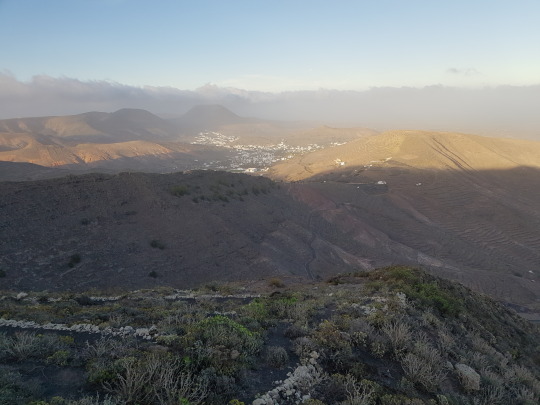
En outre, de toute les îles de l’archipel des Canaries, c’est celle sur laquelle l’action du volcanisme reste la plus visible : elle comporte plus de 300 dômes volcaniques, et une très grande partie de son sol est recouvert de lave séchée. Voici un de ces dômes, plutôt oxydé
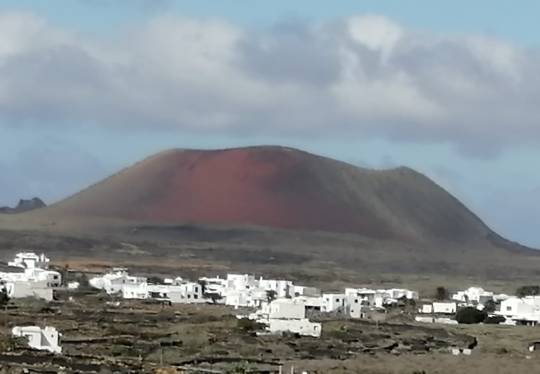
Les habitations sont blanches et n’ont qu’exceptionnellement plus d’un étage en dehors d’ Arrécife ; celles qui sont isolées se remarquent bien dans le paysage
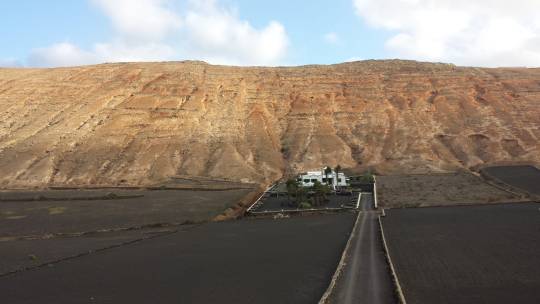
On peut quand même trouver quelques cultures en plus des plantes potagères.
Il y a tout d’abord la vigne qu’il faut protéger du vent dominant (nordet) par des murets en pierres (volcaniques) sèches, appelés “socos” ou “goros”. Ils peuvent être en arc de cercle
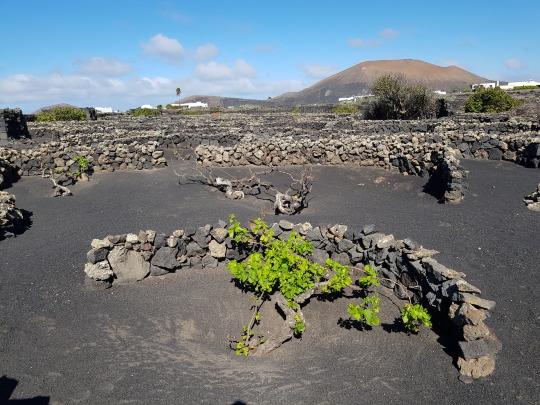
ou bien rectilignes comme ci-dessous
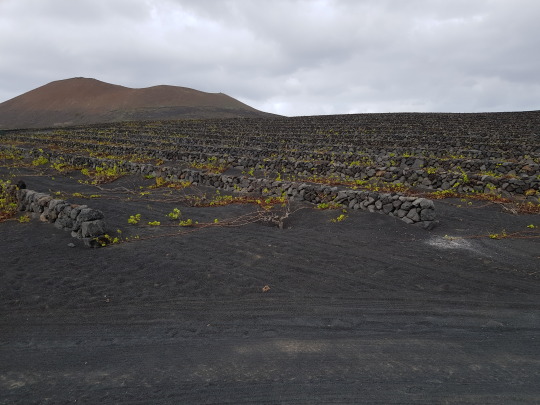
On remarquera le couleur noire du sol sur lequel on a déversé du “sable volcanique” (pyroclastique), appelé le “picón”, qui est récupéré dans des carrières situées sur les pentes des cônes volcaniques. Ces gravillons ont la propriété d’éviter la repousse des mauvaises herbes ainsi que celle de retenir l’humidité sur ce sol très sec et très peu arrosé par la pluie. En effet, le plus haut sommet de l’île n’atteignant que 670 m, cela ne suffit pas à bloquer les nuages qui ne font souvent que passer (vite...). Le nord de l’île est malgré tout plus vert et plus cultivé que le sud où se trouve surtout la vigne.
Il y a aussi la culture de l’aloé vera, qui, d’après les “magasins de fabrication” qui sont régulièrement implantés dans l’île, serait une véritable panacée : seules quelques variétés de cette plante ont de soi-disant vertus thérapeutiques ; et comme par hasard, ce sont celles qui sont cultivées à Lanzarote...
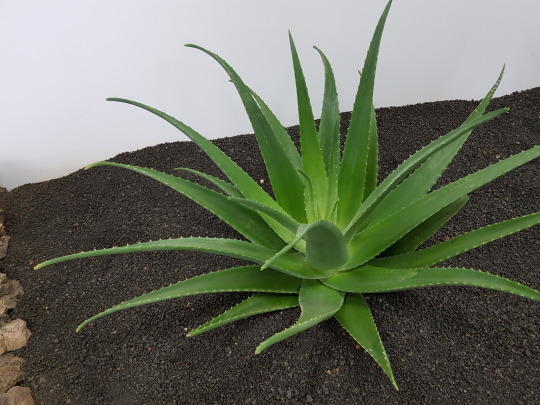
N.B. La plupart des touristes étant des Espagnols, des anglophones ou des germanophones, les affiches sont uniquement présentées dans ces trois langages, comme par exemple ci-dessous
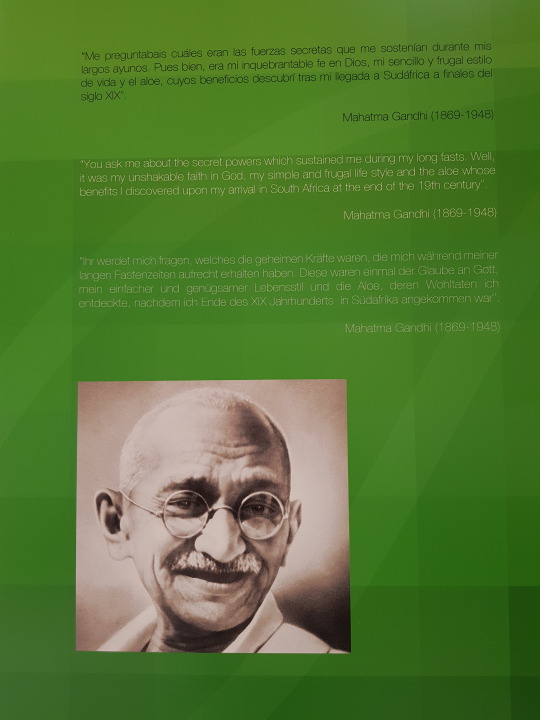
Pour ce qui est des francophones, on trouve parfois du personnel belge dans ces magasins.
Et puis n’oublions pas la culture du “figuier de Barbarie” pour ses fruits comestibles, mais surtout pour son parasite, la cochenille rouge. Une fois que les femelles sont desséchées sur la plante, leurs cadavres sont broyés pour obtenir une poudre appelée le “rouge de cochenille” ; près quelques transformations, cette poudre fournit une teinture écarlate appelée le “carmin” : il faut 100 000 femelles pour récupérer une livre de carmin...Ce colorant “naturel” est utilisé à la place des colorants synthètiques rouges mal vus car “chimiques” ; on peut en trouver dans la charcuterie, les boissons, les laitages, les cosmétiques, etc. : prudence donc pour celles et ceux qui suivent un régime “végan” !

Nous avons visité le M.I.A.C. (musée d’art contemporain) qui présentait une exposition consacrée à l’architecte Fernando de Higueras, qui aimait le béton anguleux
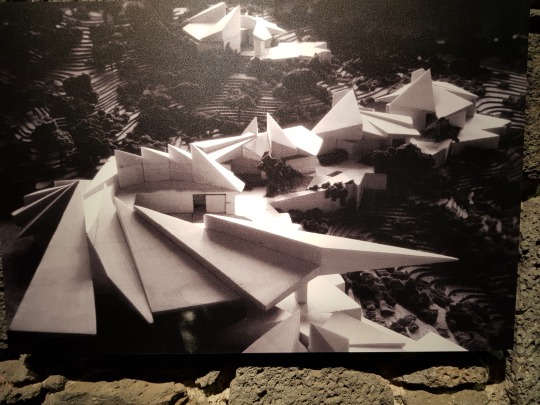
mais qui était aussi un bon dessinateur en noir & blanc

Il n’y avait que très peu d’œuvres dues à d’autres artistes, comme par exemple celle-ci (qui a une taille humaine)
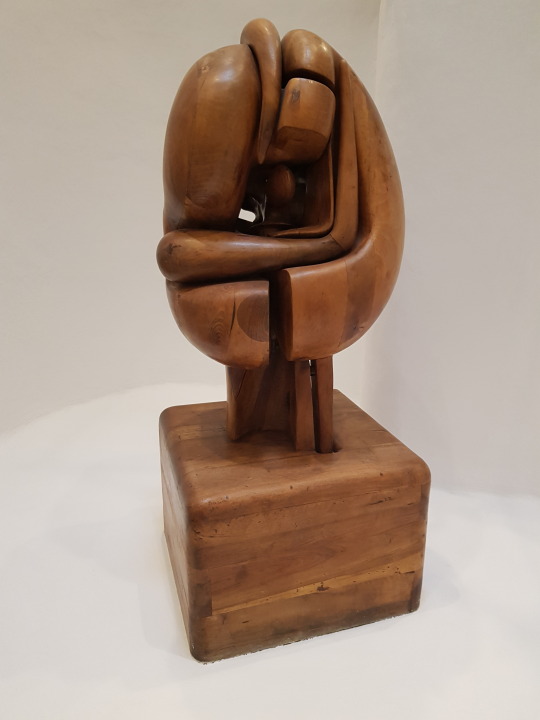
Ce musée a été créé à l’initiative de l’artiste omniprésent César Manrique (C.M. : 1919-1992). Natif de l’île, c’est lui qui en a préservé l’aspect sauvage contre les atteintes de l’urbanisme galopant. Il a aussi été le grand organisateur de l’aspect touristique de l’île, avec le soutien politique et financier de son ami d’enfance Pépin Ramirez qui était aux commandes de l’autorité locale.
Par exemple sur le parc national de Timanfaya il a fait construire un restaurant au-dessus des bouches d’un volcan, avec chauffage au sol intégré...Ce restaurant s’appelle “El Diablo”, et c’est évidemment César qui a créé son logo
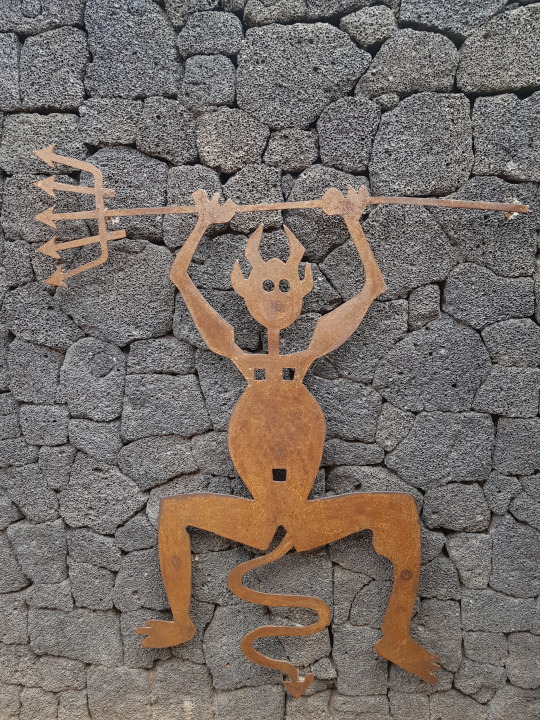
On y mange bien,
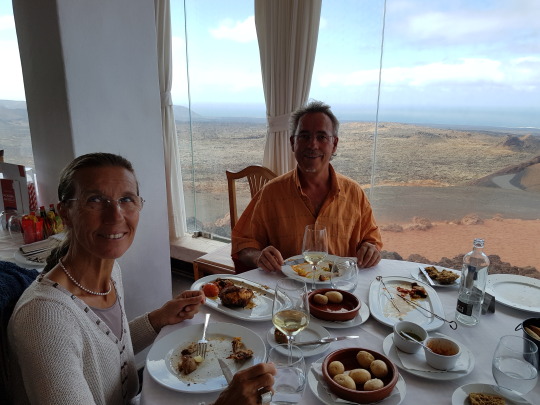
et le poulet ainsi que les brochettes avaient transités par ici

(en se penchant, on aperçoit la surface de la lave)

En regardant dehors, on peut voir une “attraction-geyser” bien calibrée
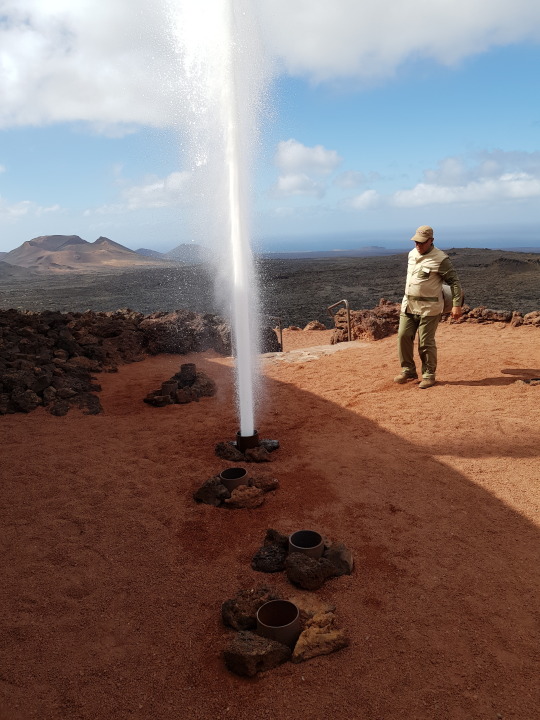
Nous avons aussi visité l’habitation-musée de ce peintre non figuratif, sculpteur et architecte, mais les prises de vue étant interdites à l’intérieur..., voici seulement l’entrée
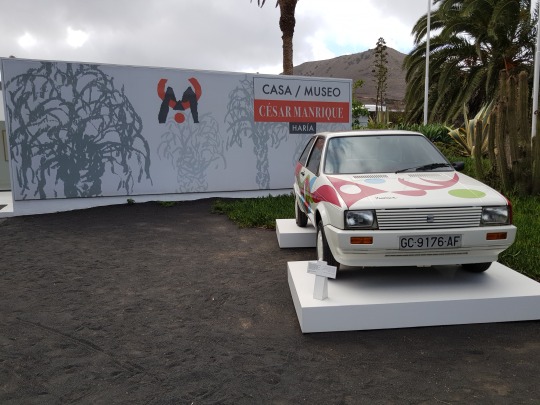
C’est aussi Manrique qui a aménagé le site de “los jameos del agua” qui est un centre d’art et de tourisme bâti dans un tunnel de lave, comprenant un restaurant
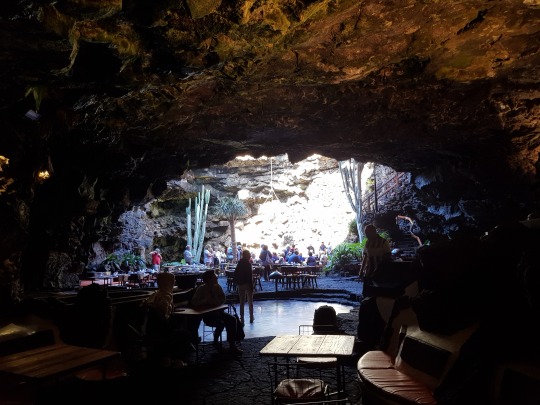
avec sa piste de danse taillée sur mesure,
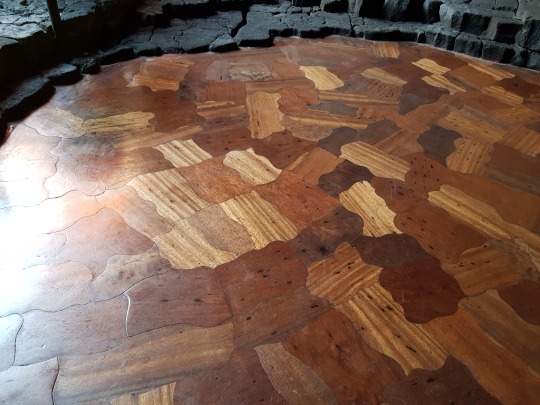
sa piscine (photo de l’en-tête), son étang où vit une espèce endémique de crabe
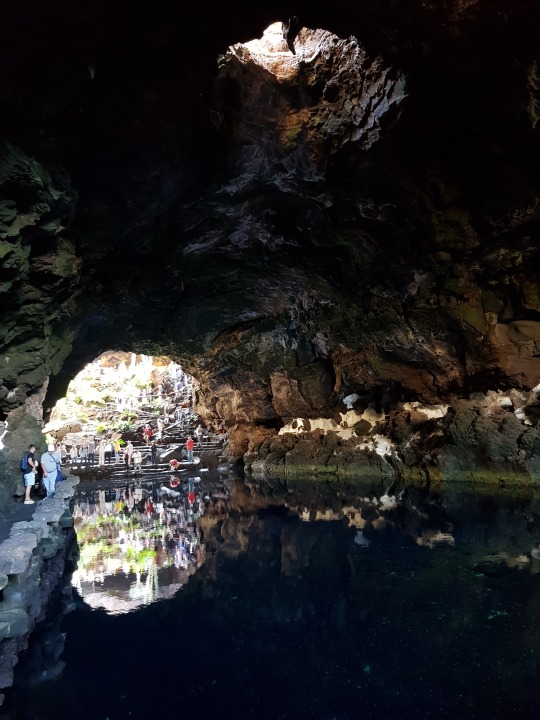
ainsi qu’un magnifique auditorium avec une acoustique remarquable
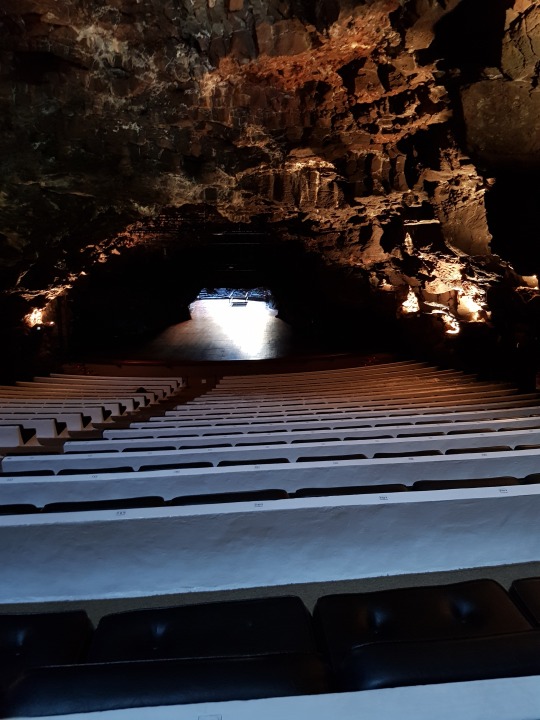
Manrique était revenu sur son île natale en 1966 après une carrière à Madrid et New York, pour y exprimer son “art total” : il a voulu privilégier la relation entre l’art et la nature, avec une sobriété fidèle à l’architecture locale et un luxe non ostentatoire qui ne provient que du paysage lui-même. Ce qui en résulte constitue sans aucun doute son chef d’œuvre artistique. On peut dire que C.M. a commencé à défendre l’équilibre écologique de Lanzarote bien avant que le mot “écologie” devienne à la mode.
Nous avons pu admirer une autre de ses réalisations “el ...”
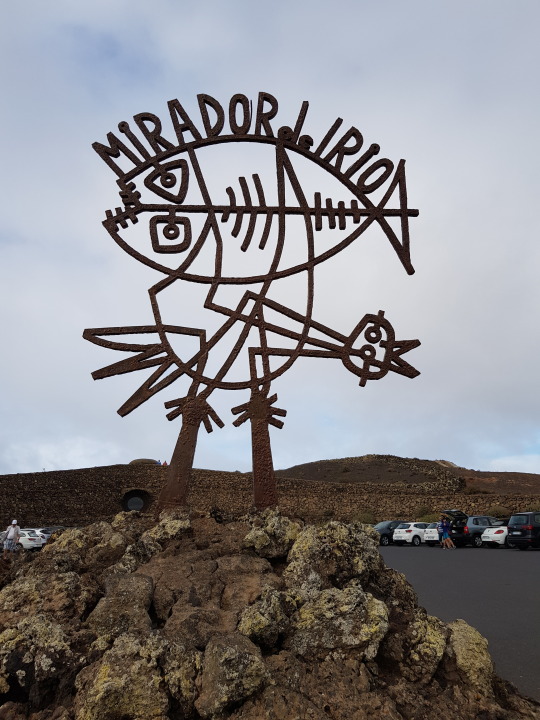
qui est encore un restaurant, mais situé cette fois-ci au-dessus du bras de mer à fort courant (comme un fleuve) qui sépare Lanzarote de La Graciosa

Dans ce restaurant nous avons pu admirer les pièces principales

ainsi que les pièces secondaires
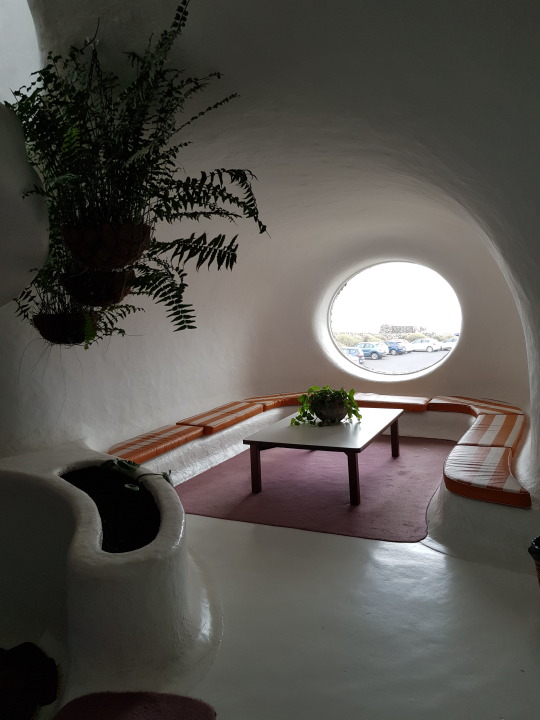
sans oublier une autre œuvre de C.M.
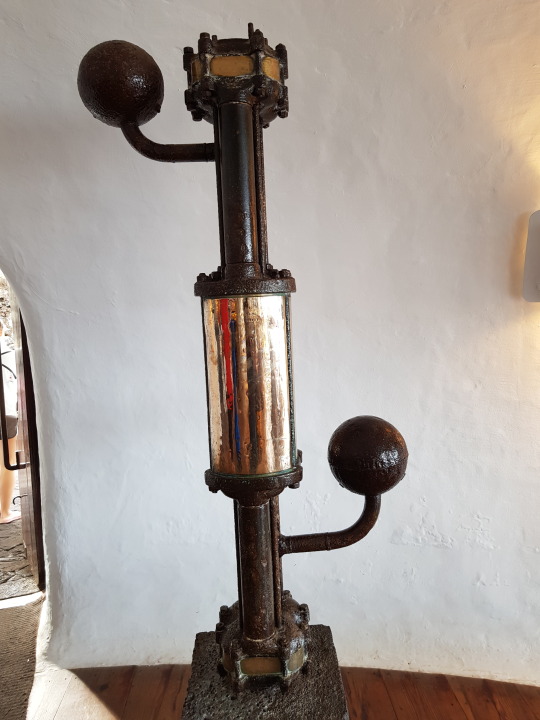
En voici quelques autres repérées à divers endroits. Tout d’abord “el monumento al campesino”
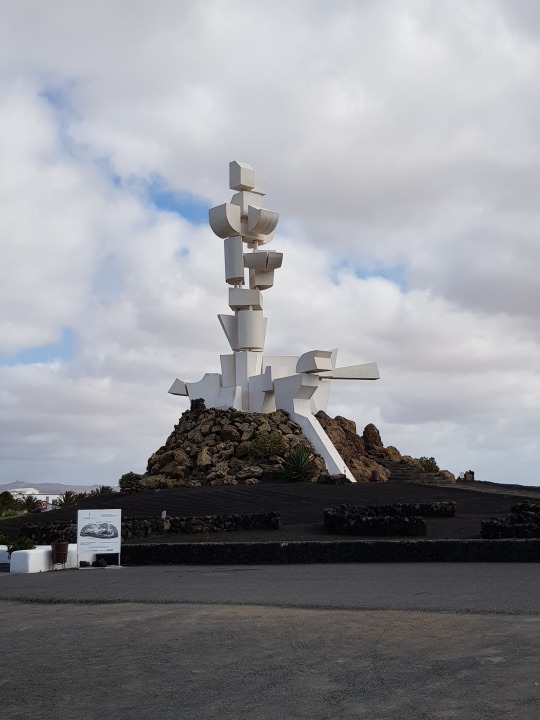
puis
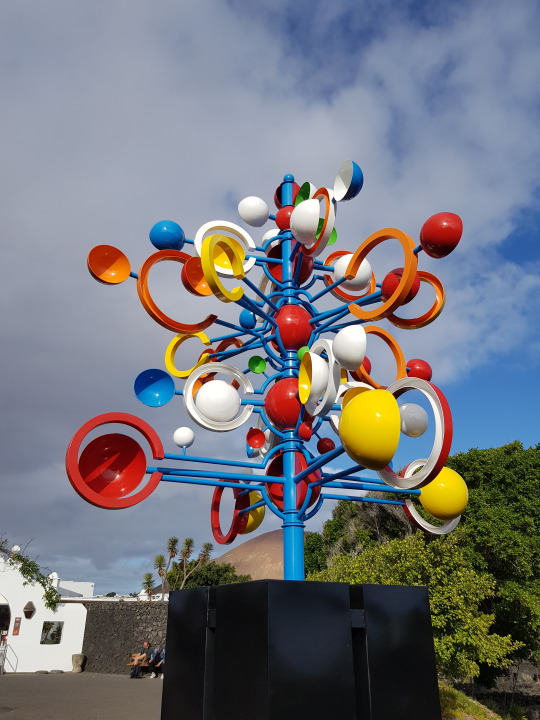
et

ainsi que
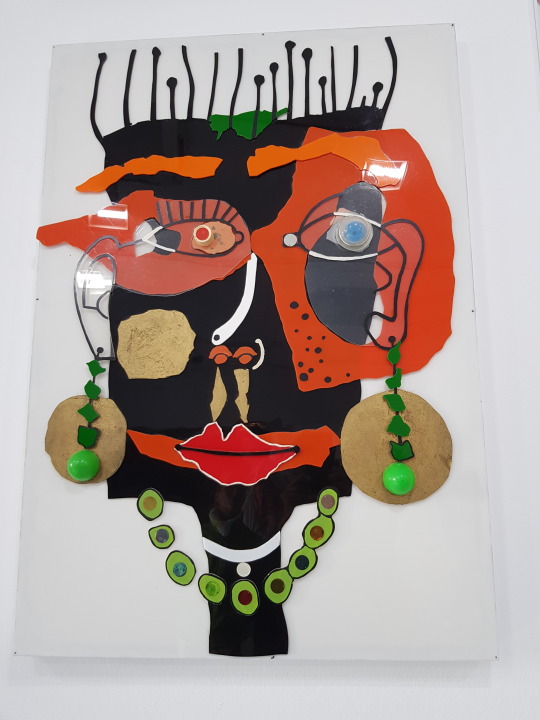
Nous avons visité ses deux habitations ; la première occupée pendant une 20aine d’années est devenue la “fondation César Manrique”, toute entière dédiée à sa gloire...Peut-être à cause du centenaire de sa naissance, C.M. était mis en scène sur tous les murs dans des situations d’auto-promotion
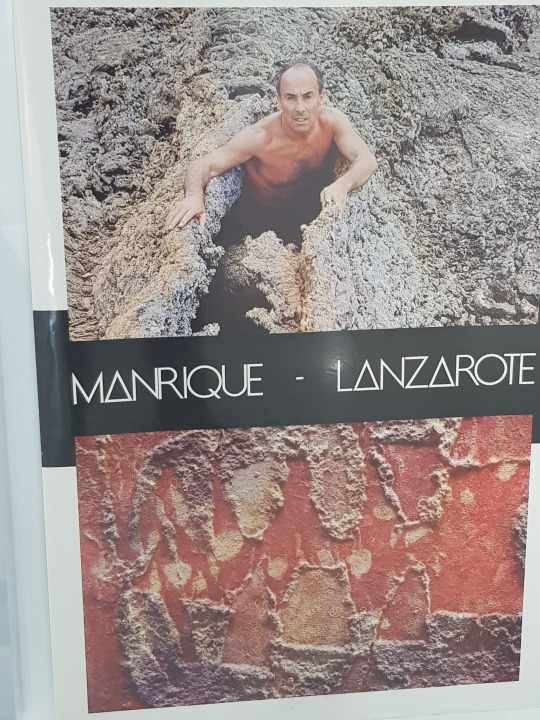
Il fréquenta, entre autres, la célèbre “usine” new-yorkaise d’Andy
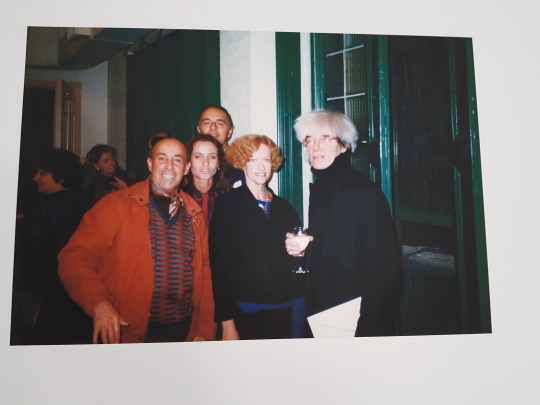
Pour terminer, voici son monogramme

et une vue globale du “jardin de cactus” qu’il a fait construire sur l’emplacement d’une carrière épuisée de “sable volcanique”
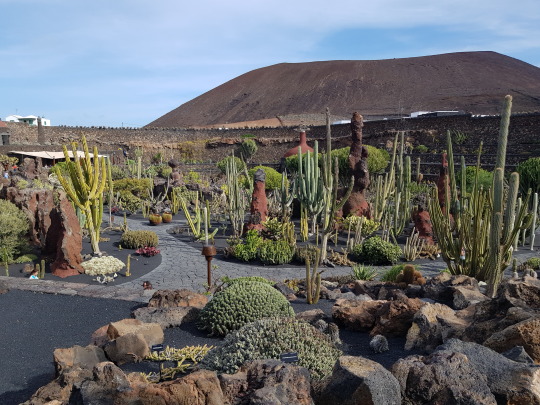
Le contenu de ce jardin fera l’objet du prochain billet...
0 notes